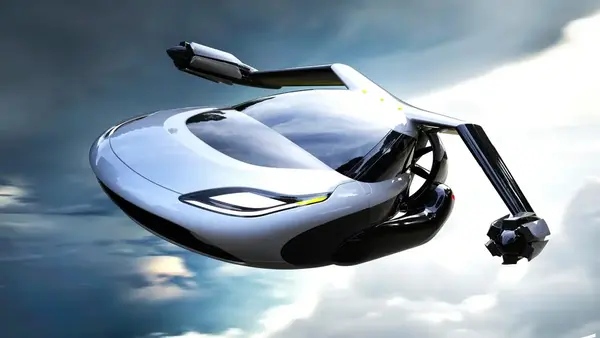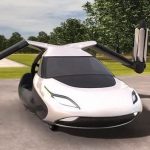The tech behind a flying car, originally developed and successfully test-flown in Europe, has been bought by a Chinese firm.
Powered by a BMW engine and normal fuel, the AirCar flew for 35 minutes between two Slovakian airports in 2021, using runways for take-off and landing.
It took just over two minutes to transform from a car into an aircraft.
Now vehicles made based on its design will be used within a “specific geographical region” of China.
Hebei Jianxin Flying Car Technology Company, headquartered in Cangzhou, has purchased exclusive rights to manufacture and use AirCar aircraft inside an undisclosed area.
The firm has built its own airport and flight school after a previous acquisition from another Slovak aircraft manufacturer, said Anton Zajac, cofounder of KleinVision, the company which created AirCar.
Having led the way in the development of the EV revolution, China is now actively developing flying transport solutions.
Last month a firm called Autoflight carried out a test flight of a passenger-carrying drone between the cities of Shenzhen and Zhuhai. The journey, which takes three hours by car, was completed in 20 minutes, it said – although the aircraft contained no passengers.
And in 2023 the Chinese firm eHang was awarded a safety certificate by Chinese officials for its electric flying taxi. Here, the UK government has said flying taxis could become a regular feature of the skies by 2028.
Government wants flying taxis taking off in 2 years
But unlike these drone-like passenger aircrafts, AirCar does not take off and land vertically, and requires a runway.
KleinVision declined to say how much it had sold the technology for. AirCar was issued with a certificate of airworthiness by the Slovak Transport Authority in 2022 and featured in a video published by YouTuber Mr Beast earlier this year.
There are still considerable hurdles for this form of transport in terms of infrastructure, regulation and public acceptance of the technology.
Similar concerns once applied to electric cars – in which China which has become a global market leader.
The sale of the Slovakian AirCar could raise questions about whether China might be poised to do the same with flying cars.
Mr Wright said while prototypes like the AirCar were “great fun”, the reality was likely to end up being more mundane “with queues and baggage checks and whatnot”.
The tech behind a flying car, originally developed and successfully test-flown in Europe, has been bought by a Chinese firm.
Powered by a BMW engine and normal fuel, the AirCar flew for 35 minutes between two Slovakian airports in 2021, using runways for take-off and landing.
It took just over two minutes to transform from a car into an aircraft.
Now vehicles made based on its design will be used within a “specific geographical region” of China.
Hebei Jianxin Flying Car Technology Company, headquartered in Cangzhou, has purchased exclusive rights to manufacture and use AirCar aircraft inside an undisclosed area.
The firm has built its own airport and flight school after a previous acquisition from another Slovak aircraft manufacturer, said Anton Zajac, cofounder of KleinVision, the company which created AirCar.
Having led the way in the development of the EV revolution, China is now actively developing flying transport solutions.
Last month a firm called Autoflight carried out a test flight of a passenger-carrying drone between the cities of Shenzhen and Zhuhai. The journey, which takes three hours by car, was completed in 20 minutes, it said – although the aircraft contained no passengers.
And in 2023 the Chinese firm eHang was awarded a safety certificate by Chinese officials for its electric flying taxi. Here, the UK government has said flying taxis could become a regular feature of the skies by 2028.
Government wants flying taxis taking off in 2 years
But unlike these drone-like passenger aircrafts, AirCar does not take off and land vertically, and requires a runway.
KleinVision declined to say how much it had sold the technology for. AirCar was issued with a certificate of airworthiness by the Slovak Transport Authority in 2022 and featured in a video published by YouTuber Mr Beast earlier this year.
There are still considerable hurdles for this form of transport in terms of infrastructure, regulation and public acceptance of the technology.
Similar concerns once applied to electric cars – in which China which has become a global market leader.
The sale of the Slovakian AirCar could raise questions about whether China might be poised to do the same with flying cars.
Mr Wright said while prototypes like the AirCar were “great fun”, the reality was likely to end up being more mundane “with queues and baggage checks and whatnot”.
The tech behind a flying car, originally developed and successfully test-flown in Europe, has been bought by a Chinese firm.
Powered by a BMW engine and normal fuel, the AirCar flew for 35 minutes between two Slovakian airports in 2021, using runways for take-off and landing.
It took just over two minutes to transform from a car into an aircraft.
Now vehicles made based on its design will be used within a “specific geographical region” of China.
Hebei Jianxin Flying Car Technology Company, headquartered in Cangzhou, has purchased exclusive rights to manufacture and use AirCar aircraft inside an undisclosed area.
The firm has built its own airport and flight school after a previous acquisition from another Slovak aircraft manufacturer, said Anton Zajac, cofounder of KleinVision, the company which created AirCar.
Having led the way in the development of the EV revolution, China is now actively developing flying transport solutions.
Last month a firm called Autoflight carried out a test flight of a passenger-carrying drone between the cities of Shenzhen and Zhuhai. The journey, which takes three hours by car, was completed in 20 minutes, it said – although the aircraft contained no passengers.
And in 2023 the Chinese firm eHang was awarded a safety certificate by Chinese officials for its electric flying taxi. Here, the UK government has said flying taxis could become a regular feature of the skies by 2028.
Government wants flying taxis taking off in 2 years
But unlike these drone-like passenger aircrafts, AirCar does not take off and land vertically, and requires a runway.
KleinVision declined to say how much it had sold the technology for. AirCar was issued with a certificate of airworthiness by the Slovak Transport Authority in 2022 and featured in a video published by YouTuber Mr Beast earlier this year.
There are still considerable hurdles for this form of transport in terms of infrastructure, regulation and public acceptance of the technology.
Similar concerns once applied to electric cars – in which China which has become a global market leader.
The sale of the Slovakian AirCar could raise questions about whether China might be poised to do the same with flying cars.
Mr Wright said while prototypes like the AirCar were “great fun”, the reality was likely to end up being more mundane “with queues and baggage checks and whatnot”.
The tech behind a flying car, originally developed and successfully test-flown in Europe, has been bought by a Chinese firm.
Powered by a BMW engine and normal fuel, the AirCar flew for 35 minutes between two Slovakian airports in 2021, using runways for take-off and landing.
It took just over two minutes to transform from a car into an aircraft.
Now vehicles made based on its design will be used within a “specific geographical region” of China.
Hebei Jianxin Flying Car Technology Company, headquartered in Cangzhou, has purchased exclusive rights to manufacture and use AirCar aircraft inside an undisclosed area.
The firm has built its own airport and flight school after a previous acquisition from another Slovak aircraft manufacturer, said Anton Zajac, cofounder of KleinVision, the company which created AirCar.
Having led the way in the development of the EV revolution, China is now actively developing flying transport solutions.
Last month a firm called Autoflight carried out a test flight of a passenger-carrying drone between the cities of Shenzhen and Zhuhai. The journey, which takes three hours by car, was completed in 20 minutes, it said – although the aircraft contained no passengers.
And in 2023 the Chinese firm eHang was awarded a safety certificate by Chinese officials for its electric flying taxi. Here, the UK government has said flying taxis could become a regular feature of the skies by 2028.
Government wants flying taxis taking off in 2 years
But unlike these drone-like passenger aircrafts, AirCar does not take off and land vertically, and requires a runway.
KleinVision declined to say how much it had sold the technology for. AirCar was issued with a certificate of airworthiness by the Slovak Transport Authority in 2022 and featured in a video published by YouTuber Mr Beast earlier this year.
There are still considerable hurdles for this form of transport in terms of infrastructure, regulation and public acceptance of the technology.
Similar concerns once applied to electric cars – in which China which has become a global market leader.
The sale of the Slovakian AirCar could raise questions about whether China might be poised to do the same with flying cars.
Mr Wright said while prototypes like the AirCar were “great fun”, the reality was likely to end up being more mundane “with queues and baggage checks and whatnot”.
The tech behind a flying car, originally developed and successfully test-flown in Europe, has been bought by a Chinese firm.
Powered by a BMW engine and normal fuel, the AirCar flew for 35 minutes between two Slovakian airports in 2021, using runways for take-off and landing.
It took just over two minutes to transform from a car into an aircraft.
Now vehicles made based on its design will be used within a “specific geographical region” of China.
Hebei Jianxin Flying Car Technology Company, headquartered in Cangzhou, has purchased exclusive rights to manufacture and use AirCar aircraft inside an undisclosed area.
The firm has built its own airport and flight school after a previous acquisition from another Slovak aircraft manufacturer, said Anton Zajac, cofounder of KleinVision, the company which created AirCar.
Having led the way in the development of the EV revolution, China is now actively developing flying transport solutions.
Last month a firm called Autoflight carried out a test flight of a passenger-carrying drone between the cities of Shenzhen and Zhuhai. The journey, which takes three hours by car, was completed in 20 minutes, it said – although the aircraft contained no passengers.
And in 2023 the Chinese firm eHang was awarded a safety certificate by Chinese officials for its electric flying taxi. Here, the UK government has said flying taxis could become a regular feature of the skies by 2028.
Government wants flying taxis taking off in 2 years
But unlike these drone-like passenger aircrafts, AirCar does not take off and land vertically, and requires a runway.
KleinVision declined to say how much it had sold the technology for. AirCar was issued with a certificate of airworthiness by the Slovak Transport Authority in 2022 and featured in a video published by YouTuber Mr Beast earlier this year.
There are still considerable hurdles for this form of transport in terms of infrastructure, regulation and public acceptance of the technology.
Similar concerns once applied to electric cars – in which China which has become a global market leader.
The sale of the Slovakian AirCar could raise questions about whether China might be poised to do the same with flying cars.
Mr Wright said while prototypes like the AirCar were “great fun”, the reality was likely to end up being more mundane “with queues and baggage checks and whatnot”.
The tech behind a flying car, originally developed and successfully test-flown in Europe, has been bought by a Chinese firm.
Powered by a BMW engine and normal fuel, the AirCar flew for 35 minutes between two Slovakian airports in 2021, using runways for take-off and landing.
It took just over two minutes to transform from a car into an aircraft.
Now vehicles made based on its design will be used within a “specific geographical region” of China.
Hebei Jianxin Flying Car Technology Company, headquartered in Cangzhou, has purchased exclusive rights to manufacture and use AirCar aircraft inside an undisclosed area.
The firm has built its own airport and flight school after a previous acquisition from another Slovak aircraft manufacturer, said Anton Zajac, cofounder of KleinVision, the company which created AirCar.
Having led the way in the development of the EV revolution, China is now actively developing flying transport solutions.
Last month a firm called Autoflight carried out a test flight of a passenger-carrying drone between the cities of Shenzhen and Zhuhai. The journey, which takes three hours by car, was completed in 20 minutes, it said – although the aircraft contained no passengers.
And in 2023 the Chinese firm eHang was awarded a safety certificate by Chinese officials for its electric flying taxi. Here, the UK government has said flying taxis could become a regular feature of the skies by 2028.
Government wants flying taxis taking off in 2 years
But unlike these drone-like passenger aircrafts, AirCar does not take off and land vertically, and requires a runway.
KleinVision declined to say how much it had sold the technology for. AirCar was issued with a certificate of airworthiness by the Slovak Transport Authority in 2022 and featured in a video published by YouTuber Mr Beast earlier this year.
There are still considerable hurdles for this form of transport in terms of infrastructure, regulation and public acceptance of the technology.
Similar concerns once applied to electric cars – in which China which has become a global market leader.
The sale of the Slovakian AirCar could raise questions about whether China might be poised to do the same with flying cars.
Mr Wright said while prototypes like the AirCar were “great fun”, the reality was likely to end up being more mundane “with queues and baggage checks and whatnot”.
The tech behind a flying car, originally developed and successfully test-flown in Europe, has been bought by a Chinese firm.
Powered by a BMW engine and normal fuel, the AirCar flew for 35 minutes between two Slovakian airports in 2021, using runways for take-off and landing.
It took just over two minutes to transform from a car into an aircraft.
Now vehicles made based on its design will be used within a “specific geographical region” of China.
Hebei Jianxin Flying Car Technology Company, headquartered in Cangzhou, has purchased exclusive rights to manufacture and use AirCar aircraft inside an undisclosed area.
The firm has built its own airport and flight school after a previous acquisition from another Slovak aircraft manufacturer, said Anton Zajac, cofounder of KleinVision, the company which created AirCar.
Having led the way in the development of the EV revolution, China is now actively developing flying transport solutions.
Last month a firm called Autoflight carried out a test flight of a passenger-carrying drone between the cities of Shenzhen and Zhuhai. The journey, which takes three hours by car, was completed in 20 minutes, it said – although the aircraft contained no passengers.
And in 2023 the Chinese firm eHang was awarded a safety certificate by Chinese officials for its electric flying taxi. Here, the UK government has said flying taxis could become a regular feature of the skies by 2028.
Government wants flying taxis taking off in 2 years
But unlike these drone-like passenger aircrafts, AirCar does not take off and land vertically, and requires a runway.
KleinVision declined to say how much it had sold the technology for. AirCar was issued with a certificate of airworthiness by the Slovak Transport Authority in 2022 and featured in a video published by YouTuber Mr Beast earlier this year.
There are still considerable hurdles for this form of transport in terms of infrastructure, regulation and public acceptance of the technology.
Similar concerns once applied to electric cars – in which China which has become a global market leader.
The sale of the Slovakian AirCar could raise questions about whether China might be poised to do the same with flying cars.
Mr Wright said while prototypes like the AirCar were “great fun”, the reality was likely to end up being more mundane “with queues and baggage checks and whatnot”.
The tech behind a flying car, originally developed and successfully test-flown in Europe, has been bought by a Chinese firm.
Powered by a BMW engine and normal fuel, the AirCar flew for 35 minutes between two Slovakian airports in 2021, using runways for take-off and landing.
It took just over two minutes to transform from a car into an aircraft.
Now vehicles made based on its design will be used within a “specific geographical region” of China.
Hebei Jianxin Flying Car Technology Company, headquartered in Cangzhou, has purchased exclusive rights to manufacture and use AirCar aircraft inside an undisclosed area.
The firm has built its own airport and flight school after a previous acquisition from another Slovak aircraft manufacturer, said Anton Zajac, cofounder of KleinVision, the company which created AirCar.
Having led the way in the development of the EV revolution, China is now actively developing flying transport solutions.
Last month a firm called Autoflight carried out a test flight of a passenger-carrying drone between the cities of Shenzhen and Zhuhai. The journey, which takes three hours by car, was completed in 20 minutes, it said – although the aircraft contained no passengers.
And in 2023 the Chinese firm eHang was awarded a safety certificate by Chinese officials for its electric flying taxi. Here, the UK government has said flying taxis could become a regular feature of the skies by 2028.
Government wants flying taxis taking off in 2 years
But unlike these drone-like passenger aircrafts, AirCar does not take off and land vertically, and requires a runway.
KleinVision declined to say how much it had sold the technology for. AirCar was issued with a certificate of airworthiness by the Slovak Transport Authority in 2022 and featured in a video published by YouTuber Mr Beast earlier this year.
There are still considerable hurdles for this form of transport in terms of infrastructure, regulation and public acceptance of the technology.
Similar concerns once applied to electric cars – in which China which has become a global market leader.
The sale of the Slovakian AirCar could raise questions about whether China might be poised to do the same with flying cars.
Mr Wright said while prototypes like the AirCar were “great fun”, the reality was likely to end up being more mundane “with queues and baggage checks and whatnot”.














